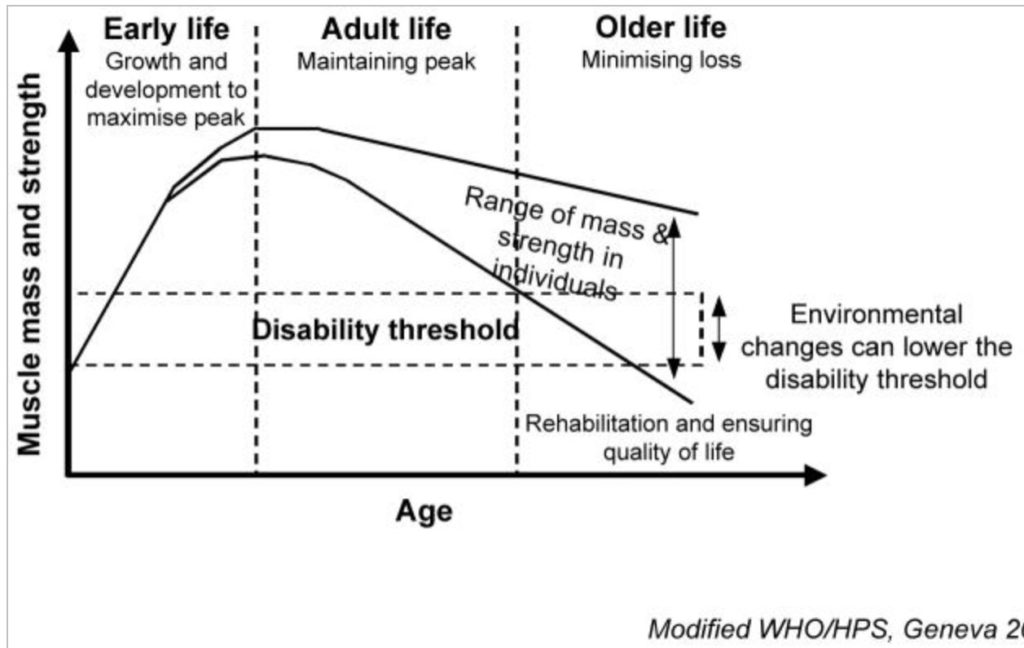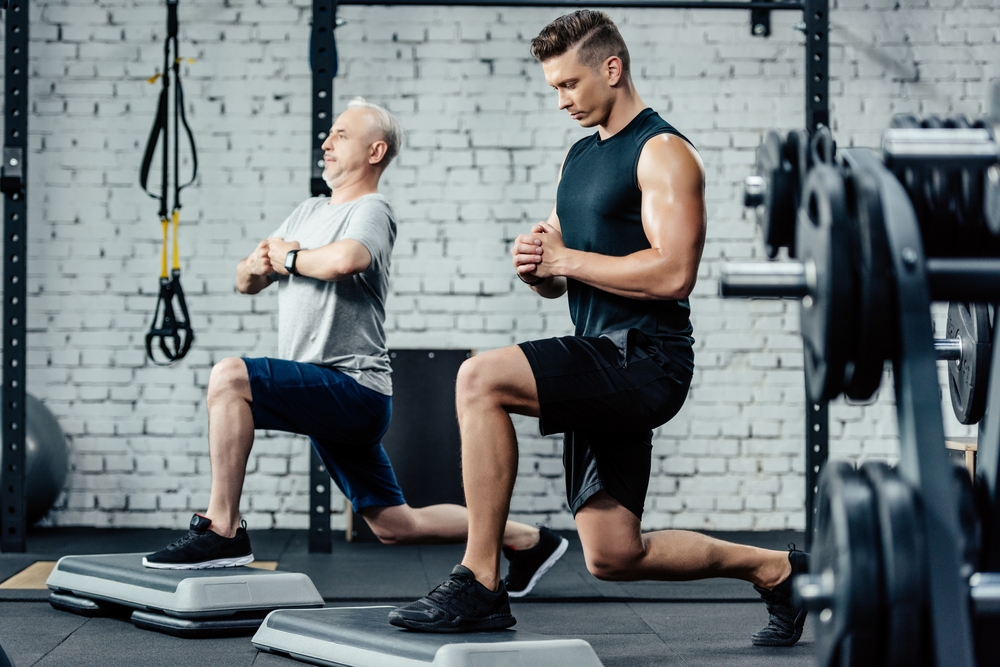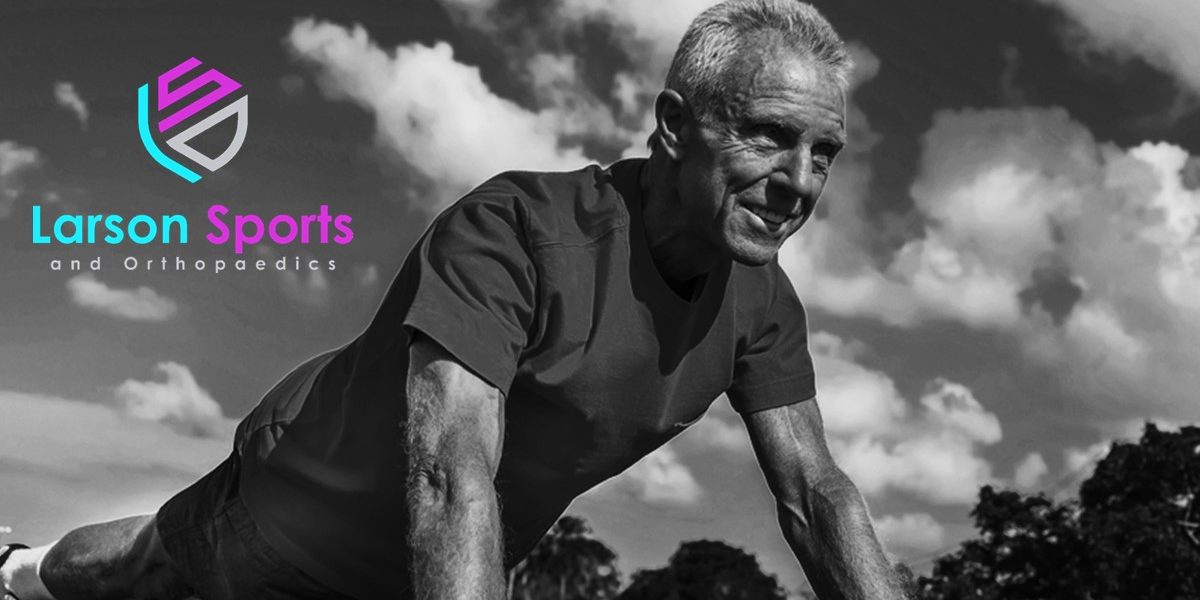Every one matures at different rates. Some people are in the best shape of their life in their 30s, 40s, or 50s. But sooner or later, we all notice that it becomes harder to add or keep muscle mass and strength. This is called sarcopenia, the normal loss of muscle with aging. But what causes decreased strength and loss of muscle that we see as people get older? And is there anything you can do to stop it? In this article, I’ll tell you about the main causes of sarcopenia, how you can fight back, and how to maintain your independence as you get older.

Dr. James Larson is an orthopedic surgeon specializing in sports medicine and arthroscopic surgery. He also holds a CF-L1 certificate and is a Certified BFR Specialist. He supports weight training and high-intensity exercise throughout the lifespan. He started LSO to keep more people moving better, longer.
Sarcopenia
Sarcopenia is the medical term for muscle loss associated with aging. Many people refer to this as atrophy, though there are some differences. Atrophy is a broad term that can refer to muscle loss from a number of causes such as nerve injury, disease, or starvation. Sarcopenia though is referring just to muscle loss from normal aging. The surprising thing is that what most people think of as getting weaker due to aging, isn’t actually part of the normal aging process at all!
When Does Sarcopenia Start?
Sarcopenia (age-related loss of muscle and strength) really doesn’t kick in until we hit our 70’s and 80’s. Before then, the progressive weakness most people get is largely due to other issues: lack of activity, poor diet, and other lifestyle factors. Yes, your peak potential for strength development is in your 20’s or 30’s. And if you’ve exercised actively your entire life, you will see a slow decline from there
But if you were like me, spending 100 hours a week working and studying until 32 years old, you probably never reached your full potential strength. This means that you could be in the best shape of your life in your 40’s or even 50s if you dedicate the time to it!

Why Do We Get Sarcopenia?
So, with normal aging, we get a very slow decline in strength after the early thirties that accelerates after 70 years of age. But why? Well, there are a couple of things that happen as we age. First, we just don’t build muscle as easily. We also see a slow decrease in muscle size. And finally, the muscles themselves become weaker even at the same size. So we see a loss of both muscle mass and loss of the strength in the muscle that we have left. Double Bummer.
But our capacity to regenerate muscle is better than we have previously dreamed possible. In fact, some studies have shown that sedentary nursing home patients in their 80’s can double their thigh muscle size in just 8 weeks with light resistance exercise. And not only is weight training and exercise safe after 60, but it’s also one of the best ways to maintain your health and wellness as you get older. Check out our previous articles on the subject here and here. In fact, it’s even safe to get back to exercise after a joint replacement.
” You Don’t Stop Playing Because You Get Old. You Get Old Because You Stop Playing.“
George Bernard Shaw
Causes of Sarcopenia
There are many mechanisms behind sarcopenia or normal muscle loss with aging. But there are even more reasons why we get early muscle loss in our 40’s and beyond. These include a variety of problems; from systemic issues like hormone levels to the loss of nerve and muscle cells, or the chemical processes inside of them. But no matter the mechanism, the ultimate cause of early muscle loss is pretty clear: Use it or lose it!
Some specific mechanisms that cause muscle loss:
- Increased Systemic Inflammation
- Decreasing Hormone Levels
- Hormone Resistance in Muscles
- Loss of Nerve Cells
- Poor Muscle Contraction Signaling
- Loss of Mitochondria From Muscle
- High Blood Pressure
- Decreased Protein Intake
- Micronutrient Deficiency
- Fat Infiltration of Muscle
- Genetics
I want to spend a few minutes going over some of the specific problems above and discussing ways you can fight back against them. Eventually (in your seventies) many of these biological processes occur naturally. But before then, many of the choices we make every day actually accelerate the process, making you old before your time.
Click HERE if you want to zip to the bottom and find out how to fight back against these changes that can rob you of your independence during old age. But if you are here to get your fitness geek on about the actual mechanics of sarcopenia, then keep reading!
Increased Systemic Inflammation
While aging used to be thought of as a single process, many experts now describe two different pathways: “healthy aging” and “inflammaging.” As you may guess, inflammaging is an acceleration of aging due to excessive, systemic inflammation. And it can cause sarcopenia far faster than normal aging.
Where does systemic inflammation come from? Well, it can be brought on by many factors: chronic disease, obesity, diabetes, smoking, pollution, lack of activity, poor diet, and chronic stress are some of the most common ones. It appears that many of our stress-response hormones, like TNF-a, work directly into the muscles and depress their ability to contract forcefully. And other stress hormones, like cortisol, actually cause muscles to atrophy and waste away.
Fortunately, a healthy diet and exercise are both capable of decreasing systemic inflammation. Keep your body fat low, maintain a healthy weight, avoid smoking and pollutants, and you can limit your systemic inflammation.
Inflammaging – the accelerated process of aging due to chronic systemic inflammation
Decreasing Hormone Levels
Levels of Testosterone, Human Growth Hormone (HGH), and Insulin-like Growth Factors (IGF) peak during our teens and twenties. Then they naturally decline over time. But did you know that exercise actually boosts your natural production of these muscle-building hormones?
Unfortunately, our body doesn’t produce as much testosterone after exercise as we age. But you still get a bump, and some increase is better than none! Other muscle-promoting hormones like HGH and IGF follow a similar pattern of decline, but also a similar improvement with resistance training and exercise. The best exercises to boost your hormone levels include full-body exercise against resistance, like deadlifts.
Hormone replacement therapy is an option if levels are extremely low. But this carries a heightened risk of some kinds of cancer as well as other negative side effects. This is something to talk about with your doctor obviously.
Hormone Resistance in Muscles
As you get older, your muscles become less responsive to all kinds of growth hormones. This occurs to some extent with natural aging but is much more commonly due to lack of exercise. The most obvious form of this problem comes in Type 2 Diabetes. In adult-onset diabetes, muscles actually become resistant to insulin and refuse to take in glucose even if there is insulin in the bloodstream.
Essentially, your muscles refuse the growth signals because they aren’t doing any work. So they shut the door on hormones like Insulin, Testosterone, and HGH. But vigorous activity will usually help open those pathways again. In people who are pre-diabetic, exercise can convince their body to respond to insulin again, keeping their blood sugar down. Similarly, exercise will improve your muscle’s response to testosterone. And resistance exercise works better than cardio for this issue. A set of resistance bands for the home can be just what the doctor ordered.
This is one problem that can’t be solved by hormone replacement. The more hormones you flood into your system, the less responsive the muscles become. Unless you stimulate those muscles with exercise they just won’t take advantage of the hormonal growth signals.

Loss of Nerve Cells
Some diseases like ALS, Huntington’s, and Parkinson’s are the result of the death of certain groups of nerves in the brain and spinal cord. In normal aging, we also see the loss of some nerve cells in the brain that control our muscles. And we see fewer connections from the remaining nerves to the muscles.
Unfortunately, muscle fibers don’t live long without a nerve connected to them. So the death of these muscle-control brain cells can lead to loss of muscle fibers as well. While this can start early in life, it seems to accelerate after 60 years of age. But once again, inactivity and systemic inflammation can worsen this brain cell loss. But vigorous exercise can keep those cells alive well into older age.
Poor Muscle Contraction Signaling
The process of life is one of continual repair of microscopic injuries that occur on a daily basis. One such injury is damage to the junction between a nerve and muscle. The body is usually pretty good at repairing this damage. But as we get older, less active, or with more inflammation we see higher rates of damage and less effective attempts to repair the neuromuscular connection.
We also see decreases in the efficiency of signal transmission from nerve to muscle. The nerve releases neurotransmitters, and when enough build-up, it triggers a contraction. With fewer neurotransmitters in the nerve, it takes longer to build up the amount required to fire that muscle fiber. And it takes longer to recover enough neurotransmitters to contract again.
For example, in your twenties, you can recover your strength after a set of squats in about one minute. But in your 70s, you may have to wait a full five minutes before your muscles are back at full strength for your next set. But fortunately (yes you guessed it!) maintaining a vigorous exercise level helps to prevent these problems.
Loss of Mitochondria From Muscle
Mitochondria, as you may remember from biology class, are “the powerhouse of the cell.” These are tiny organelles inside of cells that use oxygen and glucose to create energy for your body. They are particularly important in muscles for creating the energy to exercise. Well, without regular exercise, your mitochondria die off, since they aren’t really needed. And their capacity to create energy will also decrease.
But a vigorous exercise regimen can keep your mitochondria numbers up and keep your muscles working well. Studies show increased mitochondria numbers within 8 weeks of starting a new exercise program. This has been seen even with people in their sixties.
Of course, that means actually participating in vigorous exercise. In our sedentary society, some people have lost sight of what it means to be “active.” Cooking, cleaning house, gardening, shopping, and running errands don’t count. To keep your mitochondria healthy and prosperous, you need to perform actual exercise. This includes both weight training and cardio, not just keeping busy.
Hypertension and Sarcopenia
Blood pressure is controlled through several complex systems throughout your body. But one pathway, the Angiotensin System, has a significant effect on the smallest vessels including those that feed your muscles. ACE-inhibitors can protect muscles from various causes of atrophy, at least in mouse models. If your high blood pressure responds well to ACE-inhibitors ( including lisinopril or these other medications ) then you may actually be protecting your muscle function while keeping that blood pressure controlled.
This doesn’t mean you should take an ACE-inhibitor just to protect your muscles. But it gives you one more reason to take your medication regularly if you are already on them. And it should be noted that the Angiotensin system is activated in states of chronic inflammation, once more showing how inflammation causes muscle loss through many different mechanisms.

Decreased Protein Intake
As we age, we generally develop less of an appetite overall. And we have a tendency to slide into less healthy eating habits, with more carbs and fat. Plus we have a habit of maybe drinking a bit more than we used to. After all, what is the point of living longer if you don’t live a little, right?
But proteins are used throughout the body, not just for muscle. And if you don’t get enough protein in your diet, the body will break down muscle tissue to get it. You can prevent this by eating enough protein, so you don’t scavenge it from your healthy muscle tissue. As we get older, it’s important to supplement the protein in our diet. You can either select protein-rich whole foods to keep dietary protein high or use a supplement like protein powder to get enough every day. Whey protein seems to be especially beneficial for older adults looking to regain muscle after illness or injury.
Micronutrients and Vitamin Deficiency
It’s really important to get enough micronutrients regardless of age. And low levels of particular are associated with muscle atrophy, decreased muscle force production, and easier fatigue. Most important are vitamins with antioxidant properties including vitamins A, E, B6, and B12, folate, selenium, and zinc. So it becomes very important to take supplement these micronutrients as we age and our dietary intake and diversity narrows down.
If you’re looking for a supplement that covers all of these vitamins, try either of these: Whole Food Multivitamin Plus or NATURELO One Daily Multivitamin. I’ve done the research for you and these two have adequate amounts of all of the above micronutrients without overdosing you on any of them. If you are looking for a multi-vitamin that helps prevent muscle loss with aging, these are your best bets. You do still need separate supplements for Vitamin D and Calcium though.
Fat Infiltration of Muscle
As we get older, our lean muscle mass does decrease. We see that fat begins to infiltrate the muscles, growing between the major muscle groups. This decreases our overall muscle mass while retaining the same general size and body shape.
Unfortunately, losing weight doesn’t seem to prevent this fatty deposition. When we look at a study of more than 1500 people in their seventies, we see that fatty deposits build in muscles even if you lose weight over a five year period. Fortunately though, losing weight does decrease the fat throughout the rest of your body which improves your risk for other diseases.
Genetics
Last but not least, the one thing you can’t change: Your Genes. It seems that nature is nearly as important as nurture, and roughly 50% of your maximum strength and muscle bulk is inherited. Some people grow muscle easier and retain it better even without exercising. Similarly, some people lose muscle mass faster than others during aging. So for some of us, exercise and strength training can allow us to grow muscle even into old age, while some of us will have to work hard just to slow the loss. But no matter what, exercise will keep you moving better and stronger than you would otherwise!

Ways To Decrease Muscle Loss While Aging
- Maintain a Vigorous Exercise Regimen including Weight Training and Cardio
- Maintain a Healthy Weight and Low Body Fat
- Eat A Healthy Diet including Omega-3’s
- Supplement Protein and Micronutrients
- Have an Active Life Outside of the Gym
Maintain a Vigorous Exercise Regimen including Weight Training and Cardio
This helps in many, many ways. It reduces systemic inflammation; prevents brain and spinal cord muscle-control cells; maintains proper neuromuscular signaling; raises testosterone and other pro-muscle hormone levels; improves hormone function; keeps mitochondria levels healthy; helps control high blood pressure. To be effective, this should push your heart rate above 50% of maximum. Subtract your age from 220 to find your maximum heart rate.
And it’s best to include resistance training in addition to cardio to avoid early sarcopenia. A set of resistance bands can really help with that. Or get the best of both worlds and do high-intensity interval training. Be sure to work with a professional trainer or physical therapist if you haven’t been to the gym in a long time, or have chronic medical conditions. Exercise can still help you, but you need to do it safely!
Maintain a Healthy Weight and Low Body Fat
Excessive body fat leads to many problems: increased inflammation; decreased hormone levels; reduced responses to hormones; high blood pressure; and increased fatty muscle infiltration. These are all problems that can lead to inflammaging and early sarcopenia. But keeping a low body fat percentage and healthy weight prevents these problems.
Eat A Healthy Diet including Omega-3’s
Omega-3 Fatty Acids are important in reducing inflammation and promoting nervous system health. These are “healthy fats” and found in fish, soy, flax and chia seeds, and walnuts. Or you can get them directly through supplements like this one: Vegan Omega 3 DHA Supplement. I recommend going vegan for your Omega-3 supplements for several reasons. It prevents overfishing, you avoid fish oil mercury contaminants, and you don’t get those nasty fish oil burps.
Supplement Protein and Micronutrients
Most older adults don’t get enough protein to support all of the enzymes and other proteins your body needs for daily life. And that means your body will start pulling it out of those big protein reservoirs, your muscles, cannibalizing these stores to support vital functions. There are many websites that can help you get enough protein in your regular diet. Try this one for a start. Or you can supplement that protein intake with drinks or powders to get your daily requirements.
Micronutrients have also been shown to be vital in maintaining muscle bulk and power, especially those with antioxidant properties. Lack of these micronutrients can accelerate muscle loss, especially as we get older. Whole Food Multivitamin Plus or NATURELO One Daily Multivitamin are both good supplements that contain the most important nutrients to support muscle health. This includes vitamins A, E, B6, and B12, folate, selenium, and zinc.
Have an Active Life Outside The Gym
Exercising 3-5 times a week is great. But adding regular activity to that workout routine is even better. And not just shopping and cleaning. I mean hiking, biking, or swimming. Get out there and play some pickleball, tennis, volleyball, or just go for a walk. Keep sending your body the signals it needs to build muscle, and it will reward you with health and independence well into old age. It turns out the old adage is true: You don’t stop playing because you get old. You get old because you stop playing.
References
Inflammation and Aging
- https://www.ncbi.nlm.nih.gov/pubmed/30682077
- https://www.ncbi.nlm.nih.gov/pubmed/17116321
- https://www.ncbi.nlm.nih.gov/pmc/articles/PMC5850851/
- https://www.ncbi.nlm.nih.gov/pmc/articles/PMC5069191/
Disease and Muscle Atrophy
Mitochondria and Aging
- https://www.ncbi.nlm.nih.gov/pubmed/23375520
- https://www.ncbi.nlm.nih.gov/pmc/articles/PMC6607712/
- https://www.ncbi.nlm.nih.gov/pmc/articles/PMC5357179/
- https://www.ncbi.nlm.nih.gov/pmc/articles/PMC1540458/
Neuromuscular Aging
- https://www.ncbi.nlm.nih.gov/pmc/articles/PMC5142309/
- https://www.ncbi.nlm.nih.gov/pubmed/19797692
- https://www.ncbi.nlm.nih.gov/pubmed/29668388
- https://www.ncbi.nlm.nih.gov/pubmed/20032234

